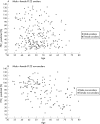Determinants of airflow obstruction in severe alpha-1-antitrypsin deficiency
- PMID: 17389752
- PMCID: PMC2117297
- DOI: 10.1136/thx.2006.075846
Determinants of airflow obstruction in severe alpha-1-antitrypsin deficiency
Abstract
Background: Severe alpha(1)-antitrypsin (AAT) deficiency is an autosomal recessive genetic condition associated with an increased but variable risk for chronic obstructive pulmonary disease (COPD). A study was undertaken to assess the impact of chronic bronchitis, pneumonia, asthma and sex on the development of COPD in individuals with severe AAT deficiency.
Methods: The AAT Genetic Modifier Study is a multicentre family-based cohort study designed to study the genetic and epidemiological determinants of COPD in AAT deficiency. 378 individuals (age range 33-80 years), confirmed to be homozygous for the SERPINA1 Z mutation, were included in the analyses. The primary outcomes of interest were a quantitative outcome, forced expiratory volume in 1 s (FEV(1)) percentage predicted, and a qualitative outcome, severe airflow obstruction (FEV(1) <50% predicted).
Results: In multivariate analysis of the overall cohort, cigarette smoking, sex, asthma, chronic bronchitis and pneumonia were risk factors for reduced FEV(1 )percentage predicted and severe airflow obstruction (p<0.01). Index cases had lower FEV(1) values, higher smoking histories and more reports of adult asthma, pneumonia and asthma before age 16 than non-index cases (p<0.01). Men had lower pre- and post-bronchodilator FEV(1) percentage predicted than women (p<0.0001); the lowest FEV(1) values were observed in men reporting a history of childhood asthma (26.9%). This trend for more severe obstruction in men remained when index and non-index groups were examined separately, with men representing the majority of non-index individuals with airflow obstruction (71%). Chronic bronchitis (OR 3.8, CI 1.8 to 12.0) and a physician's report of asthma (OR 4.2, CI 1.4 to 13.1) were predictors of severe airflow obstruction in multivariate analysis of non-index men but not women.
Conclusion: In individuals with severe AAT deficiency, sex, asthma, chronic bronchitis and pneumonia are risk factors for severe COPD, in addition to cigarette smoking. These results suggest that, in subjects severely deficient in AAT, men, individuals with symptoms of chronic bronchitis and/or a past diagnosis of asthma or pneumonia may benefit from closer monitoring and potentially earlier treatment.
Conflict of interest statement
Competing interests: None.
References
Publication types
MeSH terms
Substances
Grants and funding
LinkOut - more resources
Full Text Sources
Medical
Research Materials
Miscellaneous


